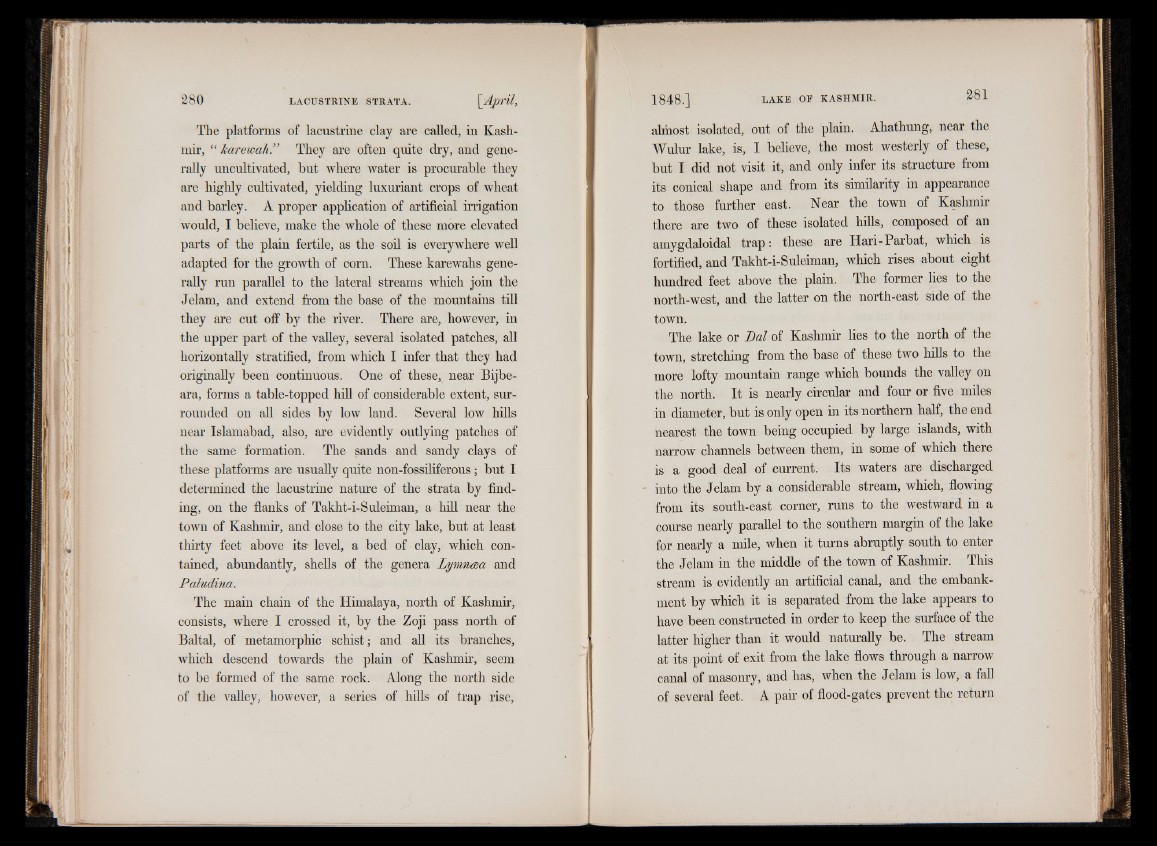
The platforms of lacustrine clay are called, in Kashmir,
“ karewah.” They are often quite dry, and generally
uncultivated, but where water is procurable they
are highly cultivated, yielding luxuriant crops of wheat
and barley. A proper application of artificial irrigation
would, I believe, make the whole of these more elevated
parts of the plain fertile, as the soil is everywhere well
adapted for the growth of corn. These karewahs generally
run parallel to the lateral streams which join the
Jelam, and extend from the base of the mountains till
they are cut off by the river. There are, however, in
the upper part of the valley, several isolated patches, all
horizontally stratified, from which I infer that they had
originally been continuous. One of these, near Bijbe-
ara, forms a table-topped hill of considerable extent, surrounded
on all sides by low land. Several low hills
near Islamabad, also, are evidently outlying patches of
the same formation. The sands and sandy
these platforms are usually quite non-fossiliferous; but I
determined the lacustrine nature of the strata by finding,
on the flanks of Takht-i-Suleiman, a hill near the
town of Kashmir, and close to the city lake, but at least
thirty feet above its- level, a bed of clay, which contained,
abundantly, shells of the genera Lymncea and
Paludina.
The main chain of the Himalaya, north of Kashmir,
consists, where I crossed it, by the Zoji pass north of
Baltal, of metamorphic schist; and all its branches,
which descend towards the plain of Kashmir, seem
to be formed of the same rock. Along the north side
of the valley, however, a series of hills of trap rise,
almost isolated, out of the plain. Ahathung, near the
Wulur lake, is, I believe, the most westerly of these,
but I did not visit it, and only infer its structure from
its conical shape and from its similarity in appearance
to those further east. Near the town of Kashmir
there are two of these isolated hills, composed of an
amygdaloidal trap: these are Hari-Parbat, which is
fortified, and Takht-i-Suleiman, which rises about eight
hundred feet above the plain. The former lies to the
north-west, and the latter on the north-east side of the
town.
The lake or Dal of Kashmir lies to the north of the
town, stretching from the base of these two hills to the
more lofty mountain range which bounds the valley on
the north. It is nearly circular and four or five miles
in diameter, but is only open in its northern half, the end
nearest the town being occupied by large islands, with
narrow channels between them, in some of which there
is a good deal of current. Its waters are discharged
into the Jelam by a considerable stream, which, flowing
from its south-east corner, runs to the westward in a
course nearly parallel to the southern margin of the lake
for nearly a mile, when it turns abruptly south to enter
the Jelam in the middle of the town of Kashmir. This
stream is evidently an artificial canal, and the embankment
by which it is separated from the lake appears to
have been constructed in order to keep the surface of the
latter higher than it would naturally be. The stream
at its point of exit from the lake flows through a narrow
canal of masonry, and has, when the Jelam is low, a fall
of several feet. A pair of flood-gates prevent the return